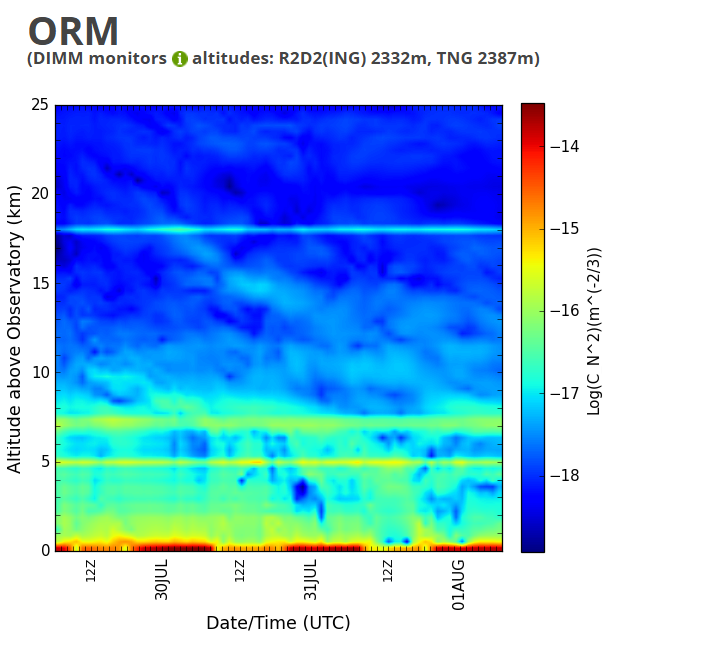Cn2 “cross-section” plot
We have called this plot “Cn2 cross-section” as it gives the evolution of the Cn2 over time (x-axys, time in UTC) for the next 72 hours predicted by the model plus the Vernin-Trinquet method (Castro Almazán et al, 2023) in the vertical of the observatory (Airmass=1) from the surface to around 25 km (Y-axys, in kilometers). The background colors show the intensity of turbulence given by the Cn2 function in the usual units of using a logarithmic scale to better visualize it, using warm colors (e.g: red) for stronger turbulence and cold colors (e.g: blue) for weaker turbulence. In the plot, one can see the usual location of turbulent layers and new ones that can develop and/or dissapear. This plot is shown above the Seeing time series so it can be used to understand the origin of the better or worse seeing at different times caused by the evolution of turbulent layers above the observatory.

References:
Julio A Castro-Almazán, Gabriel Pérez-Jordán, Casiana Muñoz-Tuñón, Begoña García-Lorenzo. Validation of turbulence profile forecasting with WRF at the Canary Islands astronomical observatories.Preliminary results. COAT2023, Mar 2023, Durham, United Kingdom. ffhal-04604975f https://hal.science/hal-04604975v1/document
Castro-Almazán J. A., Muñoz-Tuñón C., García-Lorenzo B., Pérez-Jordán G., Varela A. M., Romero I., 2016, in Observatory Operations: Strategies, Processes, and Systems VI. p.99100P, doi:10.1117/12.2232646
G Pérez-Jordán, J A Castro-Almazán, C Muñoz-Tuñón; Precipitable water vapour forecasting: a tool for optimizing IR observations at Roque de los Muchachos Observatory, Monthly Notices of the Royal Astronomical Society, Volume 477, Issue 4, 11 July 2018, Pages 5477-5485, https://doi.org/10.1093/mnras/sty943
Pérez-Jordán G., Castro-Almazán J. A., Muñoz-Tuñón C., Codina B., Vernin J., 2015, Monthly Notices of the Royal Astronomical Society, 452, 1992

